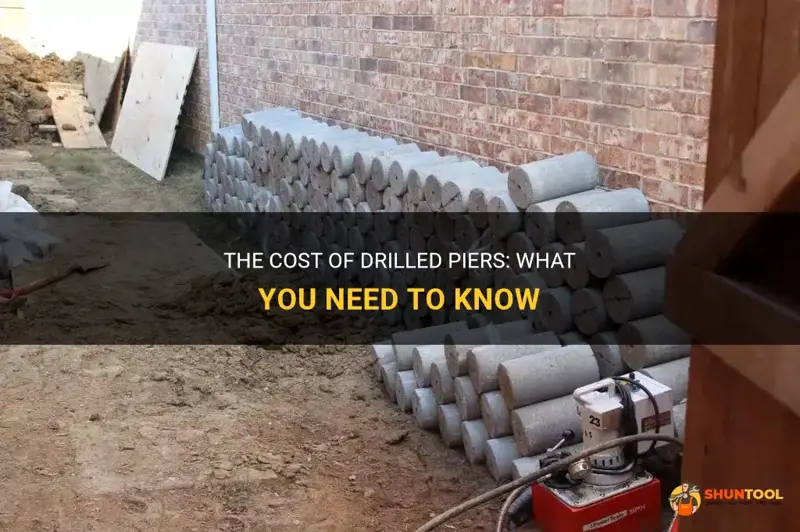
Drilled piers, also known as bored or auger piers, are an essential component of any construction project that requires a stable foundation. These deep cylindrical holes are used to provide structural support and stability for buildings, bridges, and other structures. However, one question that often arises before embarking on a construction project is how much do drilled piers cost? Well, the answer to that question can vary based on a multitude of factors, such as the size and depth of the piers, the soil conditions at the site, and the labor and equipment required. In this article, we will explore the average costs associated with drilled piers and highlight some key considerations to help you budget for your next construction project.
What You'll Learn
- What factors contribute to the cost of drilled piers?
- Are there any alternatives to drilled piers that could potentially be more cost-effective?
- How does the cost of drilled piers vary across different regions or areas?
- Are there any additional costs or considerations that should be factored in when budgeting for drilled piers?
- Can the cost of drilled piers be negotiated or are the prices typically fixed?

What factors contribute to the cost of drilled piers?
Drilled piers, also known as drilled shafts or caissons, are deep foundation elements that are used to support large structures such as buildings, bridges, and towers. They are typically made of reinforced concrete and are constructed by drilling a hole into the ground and filling it with concrete. The cost of drilled piers can vary greatly depending on several factors.
One of the main factors that contribute to the cost of drilled piers is the size and depth of the pier. Larger and deeper piers require more materials and labor to construct, which increases the overall cost. The size and depth of the pier are determined by the load that needs to be supported and the soil conditions at the site. In general, sites with poor soil conditions or high water tables may require larger and deeper piers, resulting in higher costs.
Another factor that contributes to the cost of drilled piers is the availability and cost of construction materials. The main material used in drilled piers is concrete, which can vary in cost depending on factors such as location, market demand, and the specific mix design required for the project. Additionally, the reinforcing steel used in the piers can also contribute to the cost, as the amount and type of steel required will depend on the design and load requirements of the structure.
The location and accessibility of the project site can also impact the cost of drilled piers. Sites that are more remote or difficult to access may require additional equipment and manpower, which can increase the overall cost of construction. Similarly, sites with limited working space or tall structures nearby may require specialized equipment or techniques, further increasing the cost.
The construction schedule and timeline can also influence the cost of drilled piers. If the project has a tight deadline or a compressed construction schedule, it may require additional resources and overtime labor, resulting in higher costs. Additionally, unforeseen circumstances such as inclement weather or site conditions can cause delays and increase costs.
To give a more concrete example, consider a project that requires the construction of drilled piers for a high-rise building. The design calls for large and deep piers to support the weight and vibrations of the structure. The project is located in a city with high construction demand, resulting in increased material and labor costs. The site is also located in an area with difficult soil conditions, requiring additional testing and engineering expertise. Due to the tight construction timeline, the project requires additional shifts and overtime labor. All of these factors contribute to the overall cost of the drilled piers.
In conclusion, several factors contribute to the cost of drilled piers, including the size and depth of the piers, the availability and cost of materials, the location and accessibility of the project site, and the construction schedule. It is important for engineers and project managers to carefully consider these factors when estimating the cost of drilled piers for a project. By doing so, they can ensure an accurate cost estimate and make informed decisions during the construction process.
The Ideal Hammer Drill Bit Size for 1/4" Hollow Wall Explained
You may want to see also

Are there any alternatives to drilled piers that could potentially be more cost-effective?
Drilled piers, also known as drilled shafts or caissons, are a common foundation solution for various types of structures. They are deep foundation elements that provide support and stability by transferring the load from above to a deeper, more competent soil or rock layer.
While drilled piers are widely used and proven to be effective, they can be a costly solution, especially for projects with large loads or challenging site conditions. In recent years, alternative foundation solutions have been developed and implemented to provide more cost-effective options. These alternatives offer comparable performance to drilled piers while reducing construction time and cost.
One such alternative is the use of precast driven piles. These are precast concrete or steel piles that are driven into the ground using a pile hammer or vibratory equipment. Precast driven piles offer several advantages over drilled piers. First, they can be installed more quickly, resulting in significant time savings during construction. Second, they can be manufactured off-site, which allows for better quality control and reduced construction costs. Lastly, precast driven piles can be easily removed and reused, making them a sustainable choice for temporary structures or projects with changing requirements.
Another alternative to drilled piers is the use of helical piles. Helical piles are screw-like foundation elements that are twisted into the ground using specialized equipment. They are particularly useful in areas with soft or loose soil conditions. Helical piles provide similar load-bearing capacity as drilled piers but at a lower cost. The installation process is also less disruptive to the surrounding environment since it does not involve extensive excavation or the use of heavy machinery.
In some cases, a combination of these alternative solutions can be used to further optimize cost-effectiveness. For example, a project with varying soil conditions may benefit from using a combination of drilled piers in areas of dense soil or rock and helical piles in areas with soft soil.
It is important to note that the selection of the most cost-effective foundation solution depends on several factors, including the load requirements, soil conditions, and construction schedule. A thorough geotechnical investigation and analysis should be conducted to determine the most suitable option for each specific project.
In conclusion, while drilled piers are a tried and tested foundation solution, there are alternative options available that can be more cost-effective. Precast driven piles and helical piles offer comparable performance while reducing construction time and cost. By considering these alternatives, project owners and engineers can optimize the cost-effectiveness of their foundation designs.
Understanding the Steps to Drilling Your Own Well: A Comprehensive Guide
You may want to see also

How does the cost of drilled piers vary across different regions or areas?
Drilled piers, also known as drilled shafts or caissons, are a commonly used foundation system in the construction industry. They are often used to support structures such as bridges, high-rise buildings, and industrial facilities. The cost of drilled piers can vary significantly across different regions or areas due to various factors, including labor rates, material costs, and project specifications.
One of the primary factors that influence the cost of drilled piers is the labor rates in a specific region or area. Labor costs can vary based on factors such as the local cost of living, availability of skilled labor, and competition among contractors. For example, in areas with a high cost of living and a limited pool of skilled labor, the labor rates may be higher, resulting in higher overall project costs. Conversely, in areas with a lower cost of living and a surplus of skilled labor, the labor rates may be lower, leading to lower project costs.
Another factor that affects the cost of drilled piers is the cost of materials. The materials used in drilled piers can vary depending on factors such as the soil conditions, load requirements, and project specifications. For example, if a project requires drilled piers to be installed in challenging soil conditions, such as rocky or highly permeable soils, additional materials and equipment may be required, increasing the overall cost. Similarly, if a project has strict load requirements, such as a high-rise building or a bridge, the materials used in the drilled piers may need to be of higher strength and quality, resulting in higher costs.
Project specifications also play a significant role in determining the cost of drilled piers. Factors such as the depth and diameter of the drilled piers, the number of piers required, and the complexity of the drilling process can all impact the cost. For example, if a project requires deep and large-diameter drilled piers, the cost will be higher compared to a project that requires shallower and smaller-diameter piers. Similarly, if a project has a large number of drilled piers, the cost will increase.
To illustrate the cost variation across different regions or areas, let's consider two hypothetical projects. Project A is located in a major metropolitan area with a high cost of living, limited skilled labor, and challenging soil conditions. Project B is located in a rural area with a lower cost of living, surplus skilled labor, and favorable soil conditions.
In Project A, the labor rates are higher, and additional materials and equipment are required to deal with the challenging soil conditions. The project specifications also call for large-diameter drilled piers installed at considerable depths. As a result, the overall cost of drilled piers in Project A will be significantly higher compared to Project B.
In Project B, the labor rates are lower, and the soil conditions are favorable, requiring fewer materials and equipment. The project specifications call for smaller-diameter drilled piers installed at shallower depths. Consequently, the overall cost of drilled piers in Project B will be lower compared to Project A.
In summary, the cost of drilled piers can vary across different regions or areas due to factors such as labor rates, material costs, and project specifications. It is essential for project owners and contractors to consider these factors when estimating the cost of drilled piers for a specific project. Conducting a thorough site investigation, obtaining multiple cost estimates, and seeking input from experienced professionals can help ensure an accurate and realistic budget for drilled piers.
What Size Hole to Drill for an 8-Pin Connector: A Guide for Beginners
You may want to see also

Are there any additional costs or considerations that should be factored in when budgeting for drilled piers?
Drilled piers, also known as drilled shafts or caissons, are deep foundation elements used to support structures such as buildings, bridges, and transmission towers. When budgeting for drilled piers, it is important to consider not only the actual cost of the drilling process but also any additional costs and considerations that may arise throughout the construction process. This article will explore some of these factors and provide a comprehensive guide to budgeting for drilled piers.
One of the main factors to consider when budgeting for drilled piers is the geotechnical investigation. Before drilling can begin, a thorough geotechnical investigation must be conducted to understand the soil conditions at the site. This investigation involves collecting soil samples and performing tests to determine the strength and stability of the soil. The cost of this investigation should be factored into the overall budget for drilled piers.
The depth and diameter of the drilled piers are also key factors to consider when budgeting. Larger and deeper piers will require more materials and labor, resulting in higher costs. The structural engineer and geotechnical engineer will design the drilled piers based on the load requirements and soil conditions of the site. The design will specify the appropriate diameter and depth of the piers, which will help determine the overall cost.
The type of drilling equipment and techniques used can also impact the cost of drilled piers. There are various drilling methods available, including rotary drilling, auger drilling, and displacement drilling. Each method has its own advantages and disadvantages, and the choice of equipment will depend on the site conditions and specific project requirements. It is important to consult with a drilling contractor to determine the most suitable drilling method for the project and factor in the associated costs.
In addition to the drilling process itself, there are several other considerations that should be accounted for when budgeting for drilled piers. These include permits, site preparation, mobilization and demobilization, and any required cleanup or restoration work. Depending on the location and nature of the project, there may be specific permits or regulatory requirements that need to be fulfilled. It is important to research and budget for these additional costs and ensure compliance with all applicable regulations.
Furthermore, site preparation is an important consideration when budgeting for drilled piers. The site may need to be cleared, excavated, or leveled before drilling can commence. This may involve additional manpower, equipment rental, and disposal costs. Mobilization and demobilization costs should also be factored in, as the drilling contractor will need to transport the equipment and personnel to and from the site.
Lastly, it is important to consider any potential unforeseen circumstances or complications that may arise during the drilling process. These can include encountering unexpected soil conditions, encountering existing utilities or structures, or encountering water or groundwater at the site. These complications can result in additional costs for remediation and modifications to the drilled piers.
In conclusion, when budgeting for drilled piers, it is important to consider not only the cost of the drilling process but also any additional costs and considerations that may arise throughout the construction process. Factors such as geotechnical investigations, depth and diameter of the piers, drilling equipment and techniques, permits, site preparation, mobilization and demobilization, and potential complications should all be taken into account. By considering these factors and planning accordingly, a realistic and accurate budget for drilled piers can be established.
The Ultimate Guide to Drilling a Well with a Tractor
You may want to see also

Can the cost of drilled piers be negotiated or are the prices typically fixed?
Drilled piers, also known as bored piles or caissons, are commonly used in construction projects to provide deep foundation support. They are typically made of reinforced concrete and are used to transfer the load of a structure to deeper, more stable layers of soil or rock. However, one question that often arises when planning a project is whether the cost of drilled piers can be negotiated or if the prices are typically fixed.
The cost of drilled piers can vary depending on several factors, including the size and depth of the piers, the soil conditions at the construction site, and the complexity of the project. In some cases, the cost of drilled piers may be fixed, especially if the contractor has a set pricing structure or the project is being bid out to multiple contractors. However, in many cases, there is some room for negotiation.
One way to negotiate the cost of drilled piers is to obtain multiple quotes from different contractors. By seeking bids from several reputable contractors, you can compare prices and potentially negotiate a lower cost. It is important to ensure that the contractors are experienced and qualified to perform the work, as the quality of the drilled piers is crucial for the stability and safety of the structure.
Another way to negotiate the cost of drilled piers is to consider alternative foundation solutions. Depending on the specific requirements of the project, there may be alternative methods of foundation support that are more cost-effective. For example, if the soil conditions allow, a shallow foundation system such as spread footings or mat foundations may be a viable alternative to drilled piers. By exploring different options and discussing them with the contractor, you may be able to find a solution that meets the project requirements at a lower cost.
It is important to note that while negotiation may be possible, it is also crucial to ensure that the quality of the work is not compromised. Cutting costs excessively may lead to compromised structural integrity and potential safety hazards. Therefore, it is important to work with experienced professionals who can provide a fair and balanced assessment of the project requirements and the corresponding costs.
In conclusion, while the cost of drilled piers can sometimes be negotiated, it is important to balance cost considerations with the quality and safety requirements of the project. By obtaining multiple quotes, exploring alternative foundation solutions, and working with experienced professionals, it may be possible to negotiate a lower cost while still ensuring the stability and safety of the structure.
The Essential Guide to Logging a Well During Drilling
You may want to see also
Frequently asked questions
On average, the cost of drilled piers can range from $1,500 to $6,000 per pier, depending on various factors such as the size and depth of the pier, the type of soil conditions, and the location of the project. It is important to note that these figures are just averages and the actual cost can vary depending on the specific requirements of each project.
Several factors can influence the cost of drilled piers. The size and depth of the pier required for the project can have a significant impact on the cost. Other factors include the type of soil conditions, accessibility to the construction site, and the location of the project. If a project requires additional services such as soil testing, excavation, or rebar installation, these also add to the overall cost.
Yes, there can be additional costs associated with drilled piers. In addition to the cost of the piers themselves, other expenses may include permits and inspections, engineering design fees, site preparation, and any necessary demolition or removal of existing structures. It is important to consult with a construction professional to determine the full scope of work and associated costs specific to your project.







